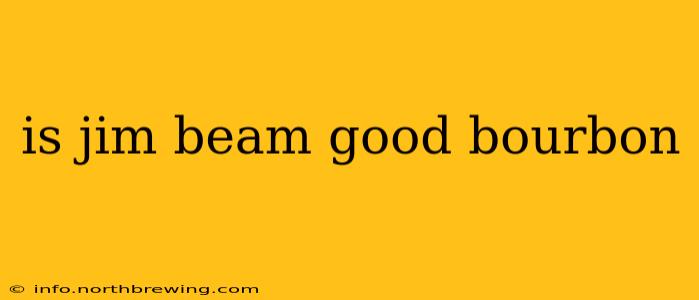Jim Beam. The name conjures images of Kentucky, of rolling hills, and of the amber liquid that's become synonymous with American whiskey. But is Jim Beam good bourbon? The answer, like many things in life, is nuanced. It depends on your palate, your preferences, and what you're looking for in a bourbon.
This isn't just a simple yes or no answer. We'll explore Jim Beam's history, its production process, its flavor profile, and compare it to other bourbons to help you determine if it's the right bourbon for you.
What Makes Jim Beam Bourbon?
Jim Beam's legacy stretches back centuries, establishing it as one of the oldest and most recognizable bourbon brands globally. Its consistent production methods and readily available nature make it a staple on shelves worldwide. But what sets it apart, and what are its defining characteristics?
-
The Mashbill: Jim Beam uses a high-rye mashbill, meaning rye makes up a significant portion of the grain mixture (along with corn and barley). This rye contributes to spicier notes and a bolder flavor profile compared to bourbons with lower rye content. The exact percentages are a closely guarded secret, adding to the brand's mystique.
-
The Fermentation and Distillation: Jim Beam employs traditional fermentation and distillation methods, passed down through generations. This consistency is a key factor contributing to their signature taste. These time-honored techniques influence the final product, delivering a familiar and reliable taste.
-
The Aging Process: The aging process is critical to bourbon's development. Jim Beam's bourbon is aged in new, charred American oak barrels, which impart color, flavor, and aroma. The length of aging varies depending on the specific expression, significantly affecting the final character.
Jim Beam's Flavor Profile: What to Expect
Many describe Jim Beam's flavor profile as smooth, with notes of caramel, vanilla, and a distinct spiciness from the rye. However, different expressions within the Jim Beam family will offer varying characteristics. Jim Beam White, for example, is younger and possesses a bolder, spicier taste, while Jim Beam Black offers a richer, more complex profile due to its longer aging.
While many appreciate its smooth and approachable nature, some might find it lacks the complexity of higher-end bourbons. This is often attributed to its high production volume and the use of a specific mashbill optimized for wide appeal rather than niche tastes.
Is Jim Beam a Good Bourbon for Beginners?
Absolutely! Its smooth taste and relatively low price point make it an excellent entry point into the world of bourbon. Its readily available nature also means it's easy to find and experiment with. It's a fantastic bourbon to help develop your palate and explore the basics of bourbon flavor profiles.
Is Jim Beam Good for Cocktails?
Yes! Its versatility shines in cocktails. Jim Beam's smooth and slightly sweet notes complement many mixers, making it an excellent base for classic bourbon cocktails like Old Fashioneds, Manhattans, and Mint Juleps. The spiciness adds a delightful dimension, enhancing the overall drink experience.
How Does Jim Beam Compare to Other Bourbons?
Comparing Jim Beam to other bourbons is a matter of personal preference. Some prefer the complexity and depth of small-batch, craft bourbons, while others value Jim Beam's accessibility and consistent quality. Higher-end bourbons often showcase nuanced flavors and aromas that are less prominent in Jim Beam due to its mass production. However, for price and availability, Jim Beam often trumps others.
What are the Different Types of Jim Beam Bourbon?
The Jim Beam family offers various expressions, each with its own distinct characteristics:
- Jim Beam White: The standard, readily available expression, known for its spiciness.
- Jim Beam Black: Aged longer for a richer, more complex flavor.
- Jim Beam Double Oak: Aged in two different sets of barrels for enhanced complexity.
- Jim Beam Devil's Cut: Incorporates a portion of the bourbon that adheres to the barrel staves, resulting in a bolder flavor.
And many more! Each variation offers a unique drinking experience and caters to diverse palates.
Ultimately, the question "Is Jim Beam good bourbon?" is subjective. Its widespread popularity speaks to its consistent quality and accessibility. While it might not offer the same level of complexity as some higher-priced bourbons, it delivers a smooth, approachable flavor that's perfect for beginners and cocktails alike. Its enduring legacy in the world of bourbon is undeniable.
